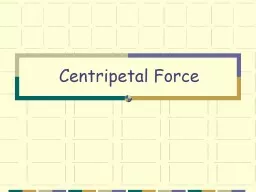

Equations Academic Vocabulary Centripetal force Centripetal acceleration Circular motion Tangential velocity Inverse square law Gravitational constant Universal gravitational force Weightlessness ID: 479060
Download Presentation The PPT/PDF document "Centripetal Force" is the property of its rightful owner. Permission is granted to download and print the materials on this web site for personal, non-commercial use only, and to display it on your personal computer provided you do not modify the materials and that you retain all copyright notices contained in the materials. By downloading content from our website, you accept the terms of this agreement.
Slide1
Centripetal ForceSlide2
Equations:
Academic Vocabulary:
Centripetal forceCentripetal accelerationCircular motionTangential velocityInverse square lawGravitational constantUniversal gravitational forceWeightlessnessTorqueCenter of massLever armRotational Equilibrium
I CAN …explain the forces that cause circular motiondetermine the motion of an object when the centripetal force is removed.differentiate between centripetal force, centripetal acceleration and tangential velocity.compare and contrast the directions of the centripetal force, centripetal acceleration, and tangential velocity.calculate centripetal force and centripetal acceleration.compare universal gravitational force between objects with different distances using the inverse square law.calculate orbital velocity using centripetal force and universal gravitation equations.calculate torque from forces perpendicular to a lever arm.calculate the torque or force necessary for an object to be in rotational equilibrium.
Circular Motion and GravitationSlide3
Inertia vs. Force
When a car accelerates, you feel as if you are flung backward.
Your inertia (mass) resists acceleration.
There is no force pushing you backward; your body wants to remain at rest as the car accelerates forward.The Normal Force of the car seat pushes you forward, but your brain interprets this feeling as a force pushing you back into the seat.Slide4
Inertia vs. Force
When a car quickly stops, you feel as if you are flung forward.
Your inertia (mass) resists the negative acceleration.
There is no force pushing you forward; your body wants to remain in motion at constant velocity as the car accelerates backwards.Your brain interprets the absence of the Normal Force of the car as a force pushing you forward. In reality, the only reason you do not fly through the windshield is because of the force of friction and normal force from the seatbelt pushing you backward.Slide5
Inertia vs. Force
When a car turns, you feel as if you are flung to the outside. Your inertia resists acceleration.
There is no force pushing you to the outside of the turn; your body simply wants to keep moving in straight line motion!In every case, the REAL force is in the opposite direction of what your brain interprets.Slide6
The “Real” Force required to turn a car
1
23The car wants to continue its current motion.At location 1, the car wants to continue to move forward (up).The force required to make a turn (or circle) must be directed toward the center of the turn.Slide7
Uniform Circular Motion
2 Conditions:Uniform (constant) speedCircle has a constant radius.Caused by a forceSlide8
Centripetal Force:
Force responsible for uniform circular motion.Tangential velocity:Speed and direction of the object at any given time.
Fc
vFcFc
v
Always toward center of circle!
v
Always tangent to the circle! (perpendicular to the Centripetal Force)Slide9
Centripetal Force
ALWAYS points toward the center of the circle.NEVER changes an object’s speed. ALWAYS changes the object’s direction.ALWAYS perpendicular to the velocity.If centripetal force is removed, the object will follow its tangential velocity.
F
cvFcFc
v
vSlide10
Concept Check:
An object moves in a circular path with a constant speed.a. Is the object’s velocity constant?No, direction of v is changing… but the speed IS constantb. Is its Fc constant?No, direction of Fc is changing… but the magnitude of Fc is constantSlide11
Concept CheckSlide12Slide13
Cause of Centripetal Force
Centripetal force is not a new type of force.You can always identify the real force which is causing the centripetal acceleration.Nearly any kind of force can act as a centripetal force.Slide14
Friction as F
cAs a car makes a turn, the force of friction acting upon the turned wheels of the car provide the centripetal force required for circular motion.Slide15
Tension as F
cAs a bucket of water is tied to a string and spun in a circle, the force of tension acting upon the bucket provides the centripetal force required for circular motion.Slide16
Normal Force as F
c Centripetal force on a spinning carnival ride is from the normal force of wall or seat on you.Slide17
Gravity as F
cAs the moon orbits the Earth, the force of gravity acting upon the moon provides the centripetal force required for circular motion.Slide18
Combination of Forces as F
c Centripetal force on a roller coaster is from the normal force and gravity combined.Slide19
If a hobo steals your truck keys and does donuts in the Wal-Mart parking lot, what is the centripetal force?
The
frictional force that exists between your tires and the ground while turning causes the truck to maintain the circular motion necessary to generate a donut.Could the hobo do donuts in a hockey rink if he stole a zomboni?No, without friction, there is no Centripetal ForceSlide20
Centripetal Acceleration:
Acceleration responsible for uniform circular motion.
v
acvac
a
c
vSlide21
Centripetal Acceleration
ac: centripetal acceleration in m/s2v: tangential speed in m/sr: radius in metersSlide22
Centripetal Force
Fc = m acFc: centripetal force in Nvt: tangential speed in m/sr: radius in metersSlide23
Example 1
A 0.5 kg object moves in a circular path with a radius of 0.25 m at a constant speed of 4.0 m/s. What is the magnitude of the object’s acceleration?Slide24
Example 2
A 5 kg bucket of water is being swung in a horizontal circle at a constant speed of 2.0 m/s. If the force required to keep the bucket moving in a circle is 25 N, What is the radius of the circular motion?